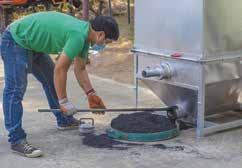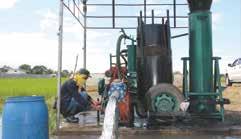
2 minute read
POWER-UP WITH CLEAN MACHINES
from Magazine 2021 3Q
by LearnPH
Power-up with clean machines COMPILED BY: REUEL M. MARAMARA AND JERALD L. BERNADES SUBJECT MATTER SPECIALIST: DR. RICARDO F. ORGE
Filipino rice farmers spend most of their production cost on labor. They devote more than 65 days for it—an exhausting feat that experts argue can be evaded through mechanization. However, most machines use fossil fuels, which prices are rising. When burned, fossil fuels produce lots of carbon dioxide (CO2), a dominant greenhouse gas that traps heat in the atmosphere, causing global warming and leading to changes in weather patterns that negatively affect agricultural production. Hence, DA-PhilRice has developed machines that help farmers produce crops efficiently and preserve the environment, too. Some of these machines produce carbon-sequestering biochar as their by-product and can possibly be labeled as carbon-negative technologies, since their emission could be less than the amount of greenhouse gas removed by their fuel (biomass) through the process of photosynthesis. Let’s meet these machines:
Advertisement
WIND PUMP
The wind has long been recorded in history as an efficient source of energy. At DA-PhilRice, the wind is being utilized for the wind pumpdrip irrigation system that consists of a 24-bladed 10m-tall windmill, water pump, water tank, and a drip irrigation system that efficiently waters the plants. Research argues that this system can pump water enough for household use and irrigate 0.3ha to 0.5ha.
Energy source: Wind energy Rotor diameter: 4.5m Pump: 44mm (1 ¾in) deep well pump or 102mm (4in) jetmatic pump Typical output: 250-500mL/s on pressure-compensating drip emitters or 10-20m3 /day at 6-12m suction head

RICE HUSK GASIFIER STOVE

Unlike most rice husk-fueled stoves in the market today that produce more smoke, the gasifier stove has blue flame and cleaner emission. It is a cheaper alternative to liquid petroleum gas-fueled stoves and more environmentally friendly as it uses farm biomass as fuel, and has zero or even negative net carbon emission.
The carbonized rice hull (CRH) produced during the process using this machine can be used as a soil conditioner.
Ignition time: burning starts after 1min upon dropping a burning paper Fuel requirement: 0.8kg rice hull/load Operating time: 30min/load Fan: 9 watts, 12 volts Water boiling time: 11min for 2L of water
CtRH CARBONIZER
The continuous rice hull carbonizer (CtRH) is a generally smokeless technology that converts rice hull into CRH that can be used as a soil conditioner. The machine also allows heat recovery for various applications like cooking, which conventionally uses fossil fuels.
RICE HULL GASIFIER ENGINEPUMP SYSTEM

Developed particularly for rainfed lowland rice farmers, this water pump system utilizes the rice hull as an energy source and produces carbonized rice hull (biochar) as a by-product. It is made of several components such as a reactor, condenser, filter, scrubber, gas tank, engine, and water pump.
The CRH produced during the process using this machine can be used as a soil conditioner.
Fuel consumption: 8.5kg rice hull/h Firing time: 5min Startup time: 5min Operating time: 120min Water discharge rate: 8-10L/s Pump size: 76mm (3in) diameter Labor requirement: 1 person
Ignition time: <2min Input capacity: 20-26kg/h rice hull Operation: Continuous mode Charcoal yield: 35-42%
For more information, please contact the DA-PhilRice Text Center at 0917-111-7423.










